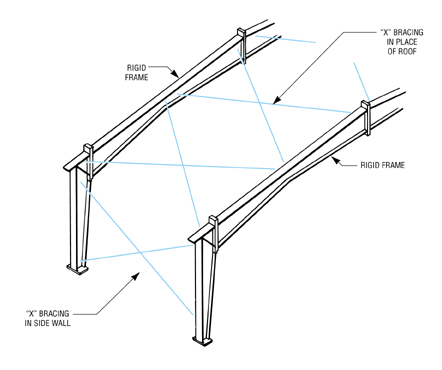

Rod/Cable “X” Bracing
Longitudinal wind/seismic forces, transferred from the top of the end
wall columns into the roof system, are then transmitted to the eave lines
by either diaphragm action of the roof sheets, when applicable, and/or
by trusses in the plane of the roof. Trusses are composed of rigid
frame rafters for top and bottom chords, purlins for compression struts,
and “X” rods for tension diagonals. From the eave lines, the longitudinal
forces are transferred to the foundation either by diaphragm action of
the wall sheeting and/or by “X” rod bracing in the sidewall.
At Ceco’s option or at customer’s request, cables may be substituted for rods.
Diaphragm action and rod bracing are used in combination to resist longitudinal wind/seismic loads. However, if cables are used in lieu of rods, they will be designed to carry the entire longitudinal wind/seismic load without using any diaphragm action form the sheeting.
When “X” bracing is used to resist longitudinal forces all braced bays
share equally in transmitting these forces to the foundation. Each
braced bay is designed to take its proportional share of the wind/seismic
loads.